
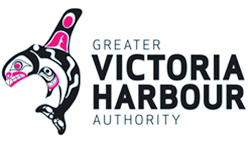 The many British tourists disembarking at the Ogden Point Cruise Terminal, a mile from downtown Victoria, often remark that the city is ‘More British than Britain’, due largely to the imposing large Empress Hotel, opened in 1908 in the Edwardian ‘French Chateau’ style to a design by Francis Rattenbury. This is a smaller version of the Frontenac Chateau opened in 1893 on the Frontenac Heights above the Port of Quebec for Canadian Pacific Hotels. After purchasing the Canadian Pacific Navigation Company in 1901 to form the British Columbia Coast Steamships division, the Canadian Pacific Railway (CPR) company, through its Canadian Pacific Hotels division, then built the Empress Hotel overlooking the Inner Harbour at Victoria. The Canadian Pacific Steamship Company operated ferries out of Victoria on a triangular route between Victoria, Vancouver and Seattle, with passengers then able to board deep sea Canadian Pacific three funnelled liners for the Far East. However, the creation of BC Ferries in 1960, based in the Parliament Buildings at Victoria (BC), put the CP Ships western passenger trade on a downward trend.
The many British tourists disembarking at the Ogden Point Cruise Terminal, a mile from downtown Victoria, often remark that the city is ‘More British than Britain’, due largely to the imposing large Empress Hotel, opened in 1908 in the Edwardian ‘French Chateau’ style to a design by Francis Rattenbury. This is a smaller version of the Frontenac Chateau opened in 1893 on the Frontenac Heights above the Port of Quebec for Canadian Pacific Hotels. After purchasing the Canadian Pacific Navigation Company in 1901 to form the British Columbia Coast Steamships division, the Canadian Pacific Railway (CPR) company, through its Canadian Pacific Hotels division, then built the Empress Hotel overlooking the Inner Harbour at Victoria. The Canadian Pacific Steamship Company operated ferries out of Victoria on a triangular route between Victoria, Vancouver and Seattle, with passengers then able to board deep sea Canadian Pacific three funnelled liners for the Far East. However, the creation of BC Ferries in 1960, based in the Parliament Buildings at Victoria (BC), put the CP Ships western passenger trade on a downward trend.
The Fairfield built CP ferry Princess of Nanaimo 6,787grt/1950 was transferred to the eastern Bay of Fundy CP service in 1963, and the iconic twin funnelled Fairfield built sisters Princess Marguerite and Princess Patricia, both 5,911grt/1949, later ended their triangular service between Vancouver, Victoria and Seattle. Princess Patricia was chartered out from the summer of 1963 for Alaskan cruising, with winter in lay-up, while Princess Marguerite continued to serve Victoria until the CP passenger service was withdrawn in September 1974. However, there was a need for the route and to avoid a subsidy she was purchased by the British Columbia Steamship Company (1975) Ltd. and operated by the Province of British Columbia Department of Transportation until the service was cancelled on 31st December 1979.
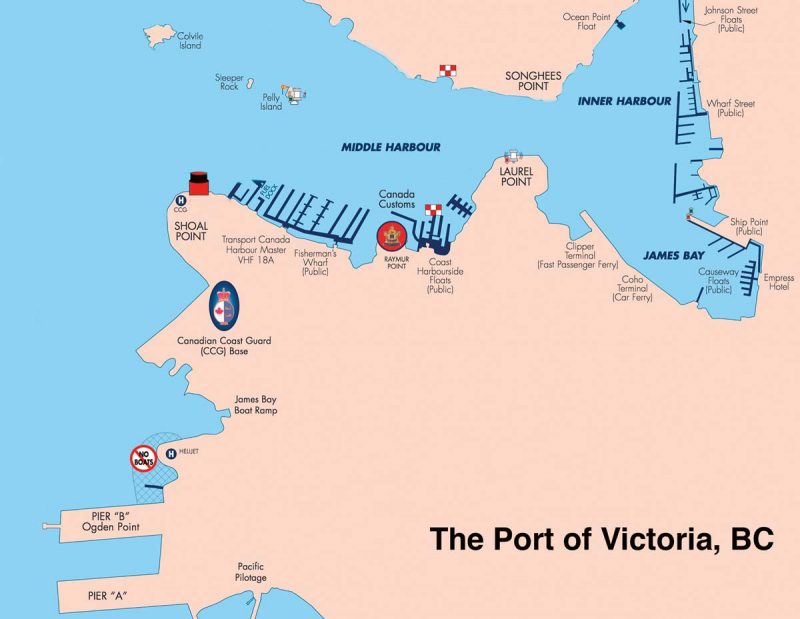
History Of Victoria (BC)
Victoria lies at the south eastern tip of Vancouver Island about 100 kilometres to the south of Vancouver and to the north of Seattle, and is bordered by the eastern end of the Juan de Fuca Strait after rounding Cape Flattery at its western end from the wild Pacific Ocean, and also the Haro Straits. It is the capital city of British Columbia with the current population of Victoria at 85,792 (2016), and it has an outer Capital Regional District (CRD) that takes in many neighbouring towns. The Native American tribes of the Coast Salish Songhees lived in settlements to the east of Victoria harbour, and the Esquimalt tribe lived to the west of it. The tall, colourful totem poles at Thunderbird Park in downtown Victoria at the entrance to the Royal British Columbia Museum are a testimony to these two tribes and the many other Native American tribes living along the Juan de Fuca Strait. Tourists can watch their descendants carving new handsome totem poles, which show and preserve the legends of the many different tribes from the aboriginal peoples of the North West Coast.
The Spanish explorers Manuel Quimper, Gonzalo Lopez de Haro and Juan Carrasco arrived in the summer of 1790 aboard their flagship Princesa Real in the Juan de Fuca Strait, where they claimed Esquimalt harbour for Spain, naming it Puerto de Cordova. However, James Douglas of the Hudson’s Bay Company in 1843 built Fort Victoria, named of course after Queen Victoria, on a site overlooking Victoria Harbour, rejecting Esquimalt harbour to the west because of its dense undergrowth. Douglas was based at a fort on the Columbia river, and his employer wanted an alternative fur trading post after the 49th parallel border settlement between Canada and the United States in 1846. The twin funnelled paddle steamer Labouchiere exported the furs for the Hudson’s Bay Company.
A beautiful walk through the forest links the two harbours today, with a seventeen gun salute fired in Victoria Harbour on 11th March 1850 by a Royal Navy frigate to witness Richard Blanshard being installed as the first Governor of the newly formed Colony of Vancouver Island. James Douglas succeeded Blanshard as Governor and concluded eleven treaties with the indigenous North American tribes between 1850 and 1854 to secure title to the land near Victoria. These today are principally the Songhees and Esquimalt First Nations, and the Tsawout and Tsardip tribes living on the Saanich peninsula. They only represent 4% of the current Victoria population, with Canadian English having 84%, and Chinese and South East Asian peoples having 12%.
During 1859/60, the Fisgard Light and Race Rocks Light were built on islands outside of Esquimalt and Victoria harbours as the first lights on the long coastline of British Columbia and still serve in that capacity today. The Fraser Canyon Gold Rush had just taken place in April 1858 with the local population of 450 people, whose lives centred around the Hudson’s Bay Company, boosted to five thousand in a few days and to more than 20,000 in a month, all living in tents around Fort Victoria and across the bay. This gold rush was followed in 1860/61 by the Cariboo Gold Rush, with prospectors struck by ‘gold fever’ arriving in ships from California and Australia in the harbour to further swell the tiny local population, with their town of Victoria becoming a city on 2nd August 1862. Prospecting lots outside Fort Victoria went up in price from $25 to $3,000 within a week.
The political function of Victoria as the capital city of British Columbia was consistent through various stages, first as the capital of the colony of Vancouver Island, then of the amalgamated colony of British Columbia in 1866, and finally of the province of British Columbia in 1871. The economic position of Victoria declined after the arrival of the Canadian Pacific Railway at Burrard Inlet at Vancouver in 1886. Vancouver by 1900 had taken over many of the shipping, commercial and manufacturing functions of Victoria, and the capital city gradually settled into its modern role as a seat of government, and recently with tourist ferry and cruise ships to bring in wealth to the capital.
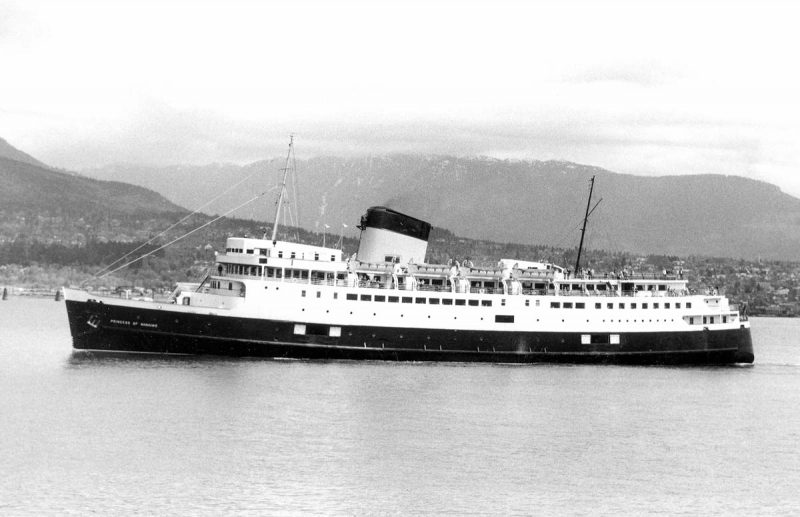
A wooden barge building shipyard at Victoria owned by Capt. William Moore found a ready market for small barges and steamers heading north to the Klondike Gold Rush in the Yukon. Capt. William Irving (1816-1872) became a partner in 1859 in the Victoria Steam Navigation Company that provided a ferry service between Victoria and New Westminster, the Irving family living at different periods in the two ports. Capt. John Irving (1854-1936) in 1882 ordered the construction in Victoria of the sternwheeler R. P. Rithet to expand his Pioneer Line fleet, replaced that year by the Canadian Pacific Navigation Company (CPNC), with John Irving as the General Manager. The purchase of the famous paddle wheeler Yosemite passenger vessel from California in 1883 set a speed record of four hours and twenty minutes for the 72 nautical mile trip between Victoria and Vancouver. This record stood until 1901 when the ocean liner Moana took only four hours and one minute for the run.
Victoria harbour had developed into a commercial harbour by 1900 while Esquimalt harbour had a naval use as the Esquimalt Royal Navy Dockyard, which was vacated by the Royal Navy in 1905 followed five years later by its occupation by the Royal Canadian Navy, which operates it today as Canadian Forces Base (CFB) Esquimalt. H.M.C.S. Malahat was the wartime name and use of the Customs House, a prominent building overlooking the Inner Harbour at Victoria and built in 1876. The Royal Victoria Yacht Club (RVYC) was founded on 8th June 1892 by a group of passionate yachtsmen, and the ‘Royal’ prefix was granted by King George V in 1911. There are several marinas in Victoria Middle and Upper Harbours today, and a new clubhouse for the RVYC on the shore of Caboro Bay in the nearby community of Oak Bay to avoid traffic on the busy approaches and harbours at Victoria. Capt. John Voss and Norman Luxton set sail from Oak Bay in 1901 to circumnavigate the globe in a 38 foot dugout canoe and reached the Thames in 1904, before later returning home, with their craft as a prominent exhibit in the Maritime Museum of British Columbia in Victoria.
After the landmark opening of the Panama Canal in 1914, traffic bound for Victoria, Seattle and Vancouver increased rapidly, and a harbour, piers and breakwater was built at Ogden Point by Canadian National Railways (CNR) and opened for business in 1916 at a cost of $5 million. In 1925, Victoria City and the Panama Pacific Grain Terminal Elevator Co. Ltd. built a grain storage silo of 93 feet in height for the shipment of grain from the Prairies. The British Columbia Packers (BC Packers) Ltd. built a fish processing and cold storage plant at Ogden Point around 1928. Fish, cement and general cargo was carried in the inter-war years by coasters owned in Victoria (BC) such as Island King 591grt/1920, Shean 420grt/1920 and Teco 194grt/1918, while the Victoria port tugs were Spray 118grt/1907 and Strath 116grt/1926.
The visit by King George VI and Queen Elizabeth to Canada and the United States of America in May and June 1939, and their arrival at Victoria (BC) on 30th May 1939 was without question the most pleasing impression on the royal couple of all the visits to towns and cities, it was the crowning gem. The royal couple arrived at Quebec on 17th May 1939 on board the liner Empress of Australia, and moved across Canada to Ottawa (20th May), Toronto (22nd May) and continued on the royal train operated by CP Railway via the Depression hit Prairies to arrive at Vancouver on 29th May. They boarded the CP coastal ferry Princess Marguerite 5,875grt/1925 for Victoria (BC) where they opened the Legislature and lunched at the Empress Hotel. The royal couple then returned east along the same route, and made a five day visit to the United States of America between 7th June and 12th June, the King becoming the first British reigning monarch to visit that country.
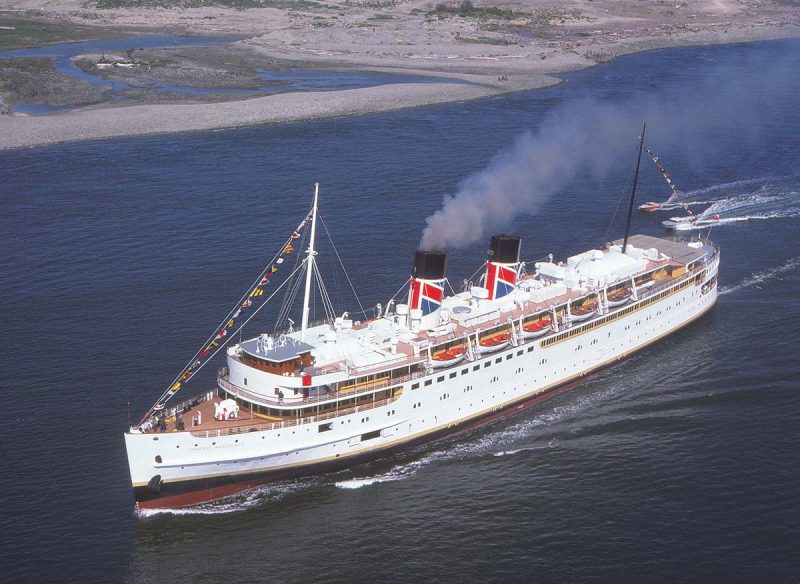
During World War II, the Victoria Machinery Depot shipyard expanded by the purchase of the Rithet Piers at the Outer Wharf for fitting-out use, and a further 27 acres of surrounding land was purchased. On 20th June 1942, the corvette H.M.C.S. Quesnel (K133) built at Victoria and based at Esquimalt responded to a torpedo attack on the standard type Fort Camosun of 10,000 dwt by the Japanese submarine I-25 off Cape Flattery. The vessel was on her maiden voyage from Victoria to British ports with a cargo of zinc, lead, plywood and general cargo. The Quesnel rescued the 31 man crew of Fort Camosun then escorted her as she was towed stern first to Neah Bay and then Esquimalt and Victoria harbours for temporary repairs. She re-entered service after being towed for permanent repairs at Seattle.
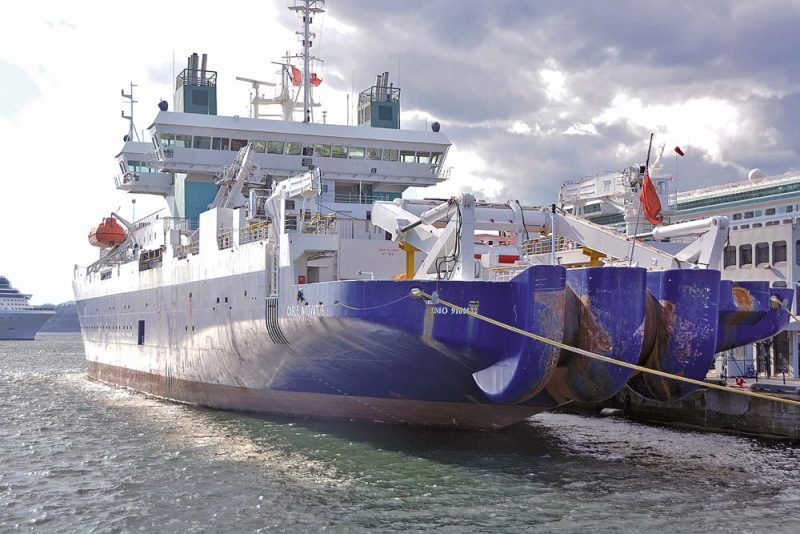
The Fisherman’s Wharf in Victoria costing $100,000 was opened on 31st March 1948 near Erie Street of length 390.0 feet and could moor sixty fish factory trawlers along six finger float piers. A big dredging operation was completed at Ogden Point in 1969, for the export of lumber and forestry products in larger bulk carriers. On 8th August 1977, a huge fire destroyed most of the facilities at Ogden Point, the fire being visible from Port Angeles in Washington State across the Juan de Fuca Strait. Thus, in 1978 Canadian National Railways (CNR) ceded Ogden Point back to Transport Canada of the Federal Government, but within five years the last of the Victoria Harbour lumber shipping companies, Sooke Forestry Products, had filed for bankruptcy. In 1975, the Outer Wharves in Victoria harbour that had been used by passenger vessels were demolished, and construction of a new Canadian Coastguard Station began and was opened there in 1980. The BC Packers cold storage fish factory was closed on 31st March 1990 due to low catches at Victoria, and it was demolished three years later.
Victoria (BC) Immigration
The first steamer to arrive with residential immigrants, apart from transient gold prospectors, was the British owned Tynemouth in September 1862 with 270 passengers including 62 women. The arrival began the key role of Victoria as an immigration centre until it was marginalised by the emergence of Vancouver as the major port of entry for British Columbia. The population of Victoria then grew to 24,000 residents in the 1890s, however the immigration facilities were limited for examining or detaining immigrants and for the immigration staff. A report in October 1906 concluded that the lack of immigration facilities, particularly for those immigrants with minor contagious diseases, was at breaking point. Land for an Immigration Hospital was purchased in the following month, and the new building opened on 13th November 1909 at the corner of Dallas and Ontario Streets in downtown Victoria.
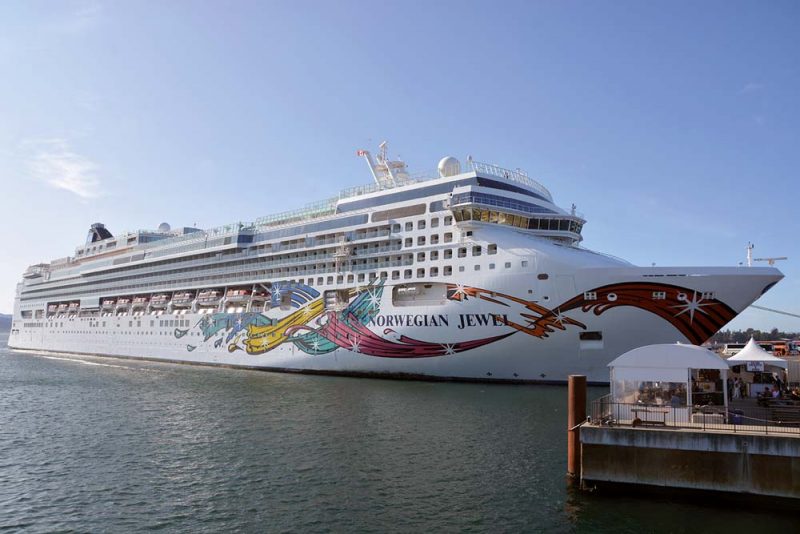
This two storey building had racially segregated wards, medical inspection centres, and administration space, and was designed to accommodate 220 Chinese, Hindu, Japanese and other nationalities while their health and residential papers were put in order. The need for the Immigration Hospital can be gauged from the fact that over 30,000 passengers were arriving at the port per annum, with the liners Kaga Maru 6,301grt/1901 of Nippon Yusen Kaisha (NYK of Japan) and Monteagle 5,468grt/1998, built by Palmers of Jarrow and transferred to the Pacific service of CPR in March 1906, regularly bringing in Chinese and Japanese immigrants. Victoria (BC) was almost as busy as Vancouver (BC) for many years with year round immigration. However, Victoria (BC) had by 1920 become largely a staging post for admission at Vancouver, with Vancouver receiving three times as many immigrants in 1930 as Victoria. This situation remained in place until the late 1960s, with the 1966 immigration figures being Vancouver (11,499) against Victoria (377), and the 1976 figures being Vancouver (25,111) against Victoria (368). Thus, Victoria (BC) had a fairly brief busy period of sixty to seventy years of mass immigration before it was displaced by Vancouver as the major gateway to British Columbia, as of course it was the western terminus of the Canadian Pacific Railway.
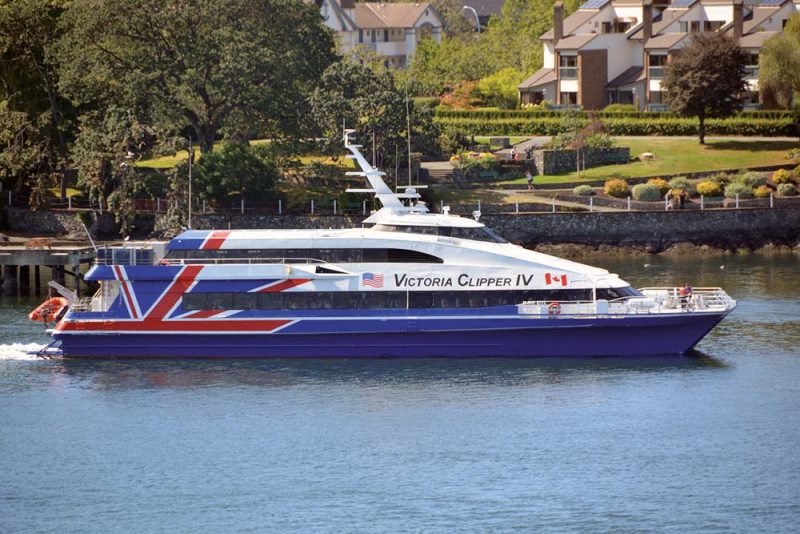
Greater Victoria Harbour Authority (GVHA)
Victoria Harbour lies at co-ordinates 48° 25′ North, 123° 3′ West, and comprises the Outer Harbour, Middle Harbour, Inner Harbour, James Bay, Upper Harbour, Selkirk Bay, Gorge Waters and Portage Inlet. The active portions of Victoria Harbour that can accommodate large merchant vessels are spread along four kilometres of harbour, with the narrow, winding harbour and its long extension of The Gorge making a picturesque port. The width of the Outer Harbour at Ogden Point is 0.46 miles, but only 449 feet in the Middle Harbour, and then widens out to the Inner and Upper Harbours. The approach to the harbour from the Juan de Fuca Strait is through the Royal Roads Strait, with Victoria Outer Harbour to starboard and Esquimalt harbour to port. The Tofino Marine Communications and Traffic Services (MCTS) handles traffic on the approach to the Juan de Fuca Strait, the Puget Sound Seattle MCTS handles traffic from Cape Flattery, and the Victoria MCTS in Patricia Bay handles traffic bound to Victoria north of Race Rocks and its lighthouse. The Greater Victoria Harbour Authority (GVHA) was incorporated in February 2002 as an associate but non-voting member of the Association of Canadian Port Authorities, and is responsible for the following water areas:-
Outer Harbour
The entrance line to the Outer Harbour extends from the breakwater just south of Pier ‘A’ at Ogden Point to Macaulay Point in Esquimalt.
Middle Harbour
The Middle Harbour is entered between Shoal Point on the Victoria side and Colville Island on the Esquimalt side. The Victoria Canadian Coast Guard station lies on Shoal Point, and there is the Fisherman’s Wharf in the Middle Harbour.
Inner Harbour
The Inner Harbour is entered between Laurel Point in Victoria and Songhees Point in Victoria West, and then extends north east to the Johnson Street Bridge. James Bay is the area in front of the Empress Hotel on the starboard side of the Inner Harbour, with a long concrete apron quay serving the needs of the Black Ball Line ferry to Port Angeles (Wa) across the Juan de Fuca Strait, the fast catamarans of the Clipper Navigation Line to Seattle (Wa), and the water taxis of the Victoria Harbour Ferry Company. BC Ferries does not serve Victoria, instead they run from the Swartz Bay Ferry Terminal to the north along the Saanich peninsula to the British Columbia mainland. Seaplanes operate higher up the Inner harbour on a busy schedule to Vancouver. Washington State Ferries also do not operate to Victoria, but instead have a service from Sidney to Anacortes. Former ferry services to Victoria Harbour from Bellingham (Wa) and Port Angeles (Wa) have included Victoria San Juan Cruises and Victoria Express Line with the vessels Victoria Star 2, Victoria Express, and Victoria Express II.
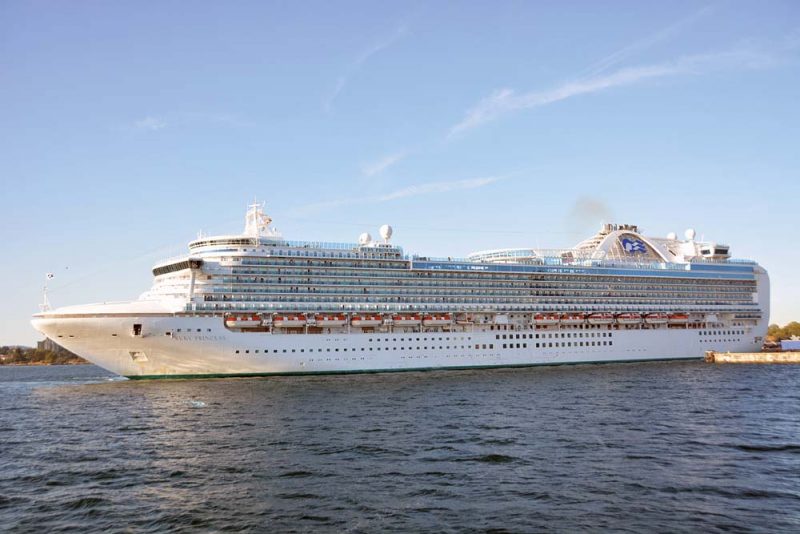

The many domed Parliament Buildings of 1897 are adjacent to the Royal British Columbia Museum and the quays in the Inner Harbour, and were also designed by Francis Rattenbury, a British architect who had arrived in Victoria the year before and won a provincial competition to design the important British Columbia Parliament Buildings in Victoria. Helicopter services are operated from the Camel Point Heliport further up the Inner Harbour, and are managed and operated by Pacific Heliport Services Ltd. for both professional transport and harbour sightseeing flights. Victoria International Airport lies thirty kilometres north of downtown Victoria, and has good connections to Vancouver to the north east, Seattle to the south east, and Prince Rupert and Alaska to the north.
Upper Harbour
The Upper Harbour extends from the Johnson Street bridge to the Point Ellice bridge or Bay Street bridge. There is an inlet to the north east of the Upper Harbour known as Rock Bay and it is home to three barge handling companies and the training topsail schooner Pacific Swift. The Gorge extends from the Upper Harbour north west from Chapman Point to Maple Point and the Craigflower bridge, and was formerly in the non polluted waters of the early 20th century the swimming and diving area for Victoria citizens. Point Hope Shipyard lies along the west bank of the Upper Harbour. Stevedore services are provided by Western Stevedoring, and the GVHA services to shipping include bonded warehousing, environmental services, Customs and Immigration, fresh potable water, medical facilities, Pacific Pilotage Authority, tugs, bunker fuel and waste disposal.
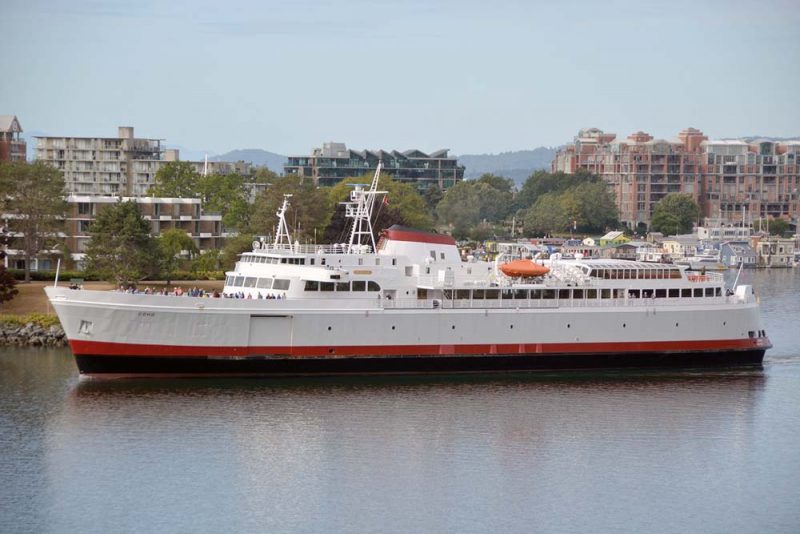
Ogden Point Cruise Terminal
The terminal has four deep water berths capable of handling vessels up to 305 metres in length with an alongside draft of 11.3 metres. This 34.6 hectare terminal can handle a variety of cruise ships, bulkers, break-bulk general cargo ships and project cargoes. The strategic location of the terminal ensure a fast turnaround of cruise ships, with modern facilities and paved parking, passenger transport to and from the terminal, line handling, gangways, fresh water, baggage handling, garbage disposal, telephones and provisioning. The main Passenger Hall has gift shops, foreign currency conversion, pay telephones, tour and shuttle buses, and taxis for the City Centre and major tourist attractions. Security and access is restricted to the berth with controlled access gates and Canada Customs and Immigration inspection areas for both Pier ‘A’ and Pier ‘B’. Pier ‘A’ South is 1,000 feet in length with the North side 800 feet in length, Pier ‘B’ both South and North berths are 1,040 feet in length as they have been extended with the installation of a mooring dolphin. All four berths are fitted with large hornhook bollards and have black cylindrical rubber bumpers placed along the dock quay. Cruise visitors are intrigued by a large ground sundial of over thirty feet in diameter.
A record of 533,000 cruise ship passengers arrived at the port on 227 cruise ships during the six month summer season of 2015. There is also a big warehouse of 100,000 square feet on Pier ‘A’ at Ogden Point that exports forestry products in geared bulkers such as Star Evviva of 39,720 dwt built in 1982 for A/S Billabong of Oslo for trading in the ‘Star’ consortium, and in smaller vessels such as Brattingsborg of 12,767 dwt built in 2010 and equipped with two heavy lift pedestal cranes. The warehouse also has a cable spinning carousel and other fibre optic cable repair equipment for retrieved cables brought in by cableships.
Black Ball Line Ferry Services
The veteran Black Ball Line ferry Coho 5,841grt/1959 will begin her sixtieth year of service in 2019 as she was completed for the company by the Puget Sound Bridge and Dry Dock Company at Seattle back in 1959 as a two deck vessel with accommodation for one thousand unberthed passengers and 115 cars accessed via both a stern and side door. She has an overall length of 104.1 metres, moulded beam of 22.0 metres, depth of 6.25 metres, and loaded draft of 4.0 metres. She has a service speed of fifteen knots from twin General Motors four stroke eight cylinder diesels developing 5,100 bhp and driving twin fixed pitch propellers of eight feet in diameter. She was re-engined in 2004 and has twin rudders and is named after the magnificent silver salmon found in Brtish Columbia and Washington State waters. The Main Deck above the car deck has a Forward Observation Lounge, Mid Ship Lounge and large Cafeteria at the stern, with stairs next to the Duty Free Shop to the Solarium Deck above. Coho makes between two and four round trips daily across the Juan de Fuca Strait dependent on season, and the one way sailing time is ninety minutes. She has a white hull with red and black boot topping, and a white funnel with an upper red band next to her black top.
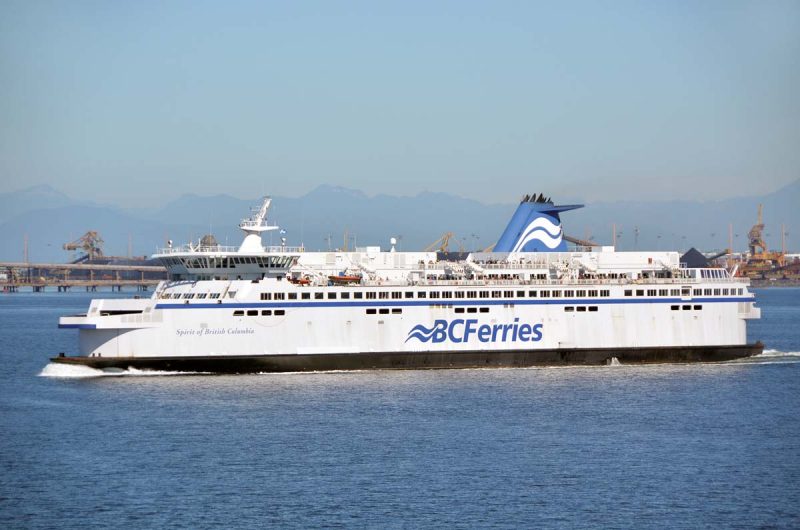
BC Ferries
BC Ferries was formed in 1960 as a provincial State owned corporation with two ferries, Queen of Tsawwassen and Queen of Sidney, on the route between the two towns of those names. In 1974, it had a big fleet of 34 ferries ranging from 175grt to 6,000grt running on a complex web of services all along the British Columbia coastline. Currently, this big fleet numbers 37 ferries, of which the two largest are Spirit of British Columbia and Spirit of Vancouver Island operating on the Tsawwassen (Mainland) to Swartz Bay near Sidney (Vancouver Island) route. The sisters are of 18,747gt and were built in 1993/94 with a capacity for 2,100 passengers and 470 cars and a voyage duration of one hour and 35 minutes. They have white hulls with a stylised blue ‘BC FERRIES’ on both port and starboard sides and a blue and white funnel. The Tsawwassen to Sidney route is the nearest to Victoria, as the now independent publicly owned company does not operate to Victoria harbour.
Ogden Point Cruise Calls In 2017
- Princess Cruises 54
- Holland America Line 41
- Norwegian Cruise Line 41
- Royal Caribbean International 21
- Celebrity Cruises 21
- Carnival Cruises 16
- Regent Seven Seas Cruises 6
- Oceania Cruises 6
- Crystal Cruises 3
- Disney Cruise Line 2
- Hapag-Lloyd Cruises 2
- Seabourn Cruises 2
- Windstar Cruises 2
- Azamara Cruises 2
- Saga Cruises 1
- Silversea Cruises 1
- Noble Caledonia Cruises 1
TOTAL 222
Shipbuilding At Victoria (BC) and Esquimalt (BC)
The Victoria Machinery Depot (VMD) yard at Victoria built 157 ships between 1888 and 1967, including five ‘Flower’ class corvettes, fourteen wartime standard ‘Fort’ and ‘Park’ tramps of 10,000 dwt, five tankers and a stores ship during World War II. VMD was originally known as the Albion Works, which opened for business in 1882 as an engine and boiler builder, becoming VMD in 1900. VMD did not assign yard numbers until World War II, starting at Yard 14, thus taking account of the thirteen vessels built previously. The original yard was in the Inner Harbour, but they moved to a yard on the Songhees Indian Reservation in World War I, and then to Ogden Point during World War II. The yard there was sold to the Canadian Coast Guard in 1967, but they continued at the Inner Harbour site as an industrial fabricator until the 1990s.
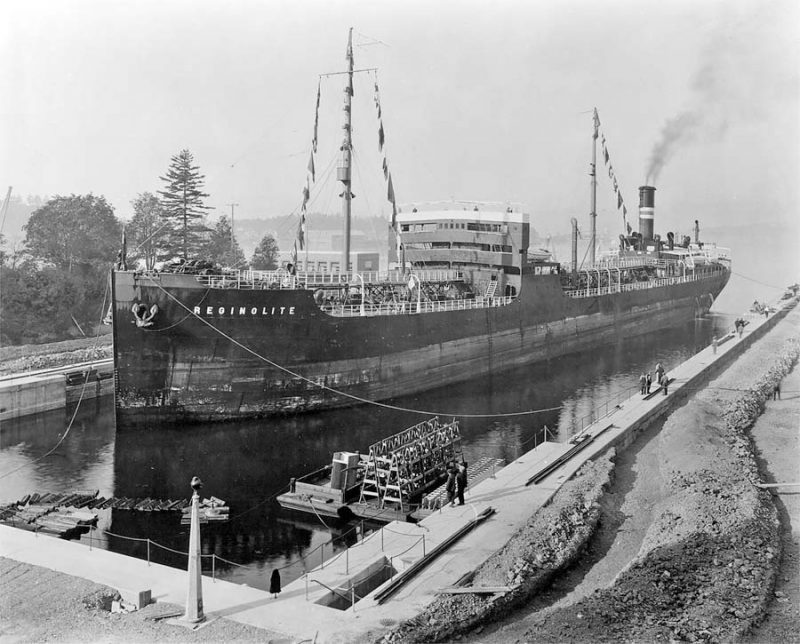
The Victoria Machinery Depot shipyard in post-war years had three berths for building vessels up to 700 feet in length, and built 68 barges including some for the Island Tug and Barge Company, as well as four patrol boats, three minesweepers, two destroyers (Terra Nova DDE259, Saskatchewan DDE262), one gate vessel and a lighter for the Royal Canadian Navy. The large State owned Esquimalt dry dock of length 1,050 feet was leased for naval and commercial vessel repair. The yard then built ferries for British Columbia Ferries until 1967 equipped with special docking bow and stern doors and Mirlees diesels to give service speeds of eighteen knots. These included Queen of Burnaby 4,903grt/1965, Queen of Sidney 3,128grt/1960, Queen of Ocoa 8,765grt/1962, Queen of Esquimalt 9,304grt/1963, Queen of Saanich 9,302grt/1963, Queen of Nanaimo 4,939grt/1964, Queen of New Westminster 8,785grt/1964, Queen of Prince Rupert 5,864grt/1966, Bowen Queen 1,125grt/1965, Mayne Queen 1,125grt/1965, Mill Bay 175grt/1956, and Powell River Queen 1,125grt/1965. Victoria Machinery Depot built the huge Transocean drilling rig Sedco 135 in 1967, and then launched their last ship in 1968 as the ro-ro vessel Doris Yorke, which was later renamed Seaspan Doris.
Yarrows Ltd. of Glasgow had a shipyard for many years in full use in the post-World War II era at Esquimalt, but it finally closed down in 1991 after six years of non shipbuilding work, while the main Scotstoun yard on the Clyde is now closed and is only used for storage use after building its last group of minesweepers and frigates for the Royal Navy. The Esquimalt yard had two building berths for vessels up to 350 feet in length, a marine railway slip of length 301 feet, and the very big Esquimalt Graving Dock of length 1,186 feet and beam of 135 feet. When the twin funnelled Cunard liner Queen Elizabeth was dry docked there in 1943 there was still 166 feet of dock space to spare.
The Bullen family began building and repairing ships in 1893 at Esquimalt, but the head of the family suffered a stroke in 1913 during a visit to Ottawa. Alfred Yarrow, born in 1842, first built ships at Poplar on the Thames before moving production to Scotstoun in 1908. He concluded a deal with the Bullen family at the end of 1913 to take over the Esquimalt yard after a scouting mission by his son Norman Yarrow looking at shipyards on both the Eastern Seaboard of Canada and in British Columbia. Alfred Yarrow paid $400,000 for 80% of the shares in the yard, with all of his shares transferred to Norman Yarrow after the retirement of his father in 1921 as a director of both shipyards. At this time, the Esquimalt yard was very well equipped with a modern machine shop, a boiler shop, joiner shop, pattern shop, plumbing, coppersmith and sheet metal shop, a pipe shop, foundry, welding shop and a galvanising plant. A fitting out wharf of length 600 feet, a sheer legs crane capable of lifting 60 tonne sections, and a similar floating crane completed the extensive facilities.
The business of the yard during the inter-war years was principally in the repair of ships, a huge total of 1,560 ships repaired during that period, with the Imperial Oil tanker Reginolite the first vessel into the big Esquimalt Graving Dock on 13th September 1926. The Graving Dock was officially opened on 1st July 1927 as the second biggest dry dock in the world, and could be divided into three sections by the clever use of inner gates, so that two very large vessels could be dry-docked simultaneously. Empress of Canada was the first big ship into the dock in 1929 after she had run aground at Albert Head. The yard built stern wheeler passenger craft and barges for the Irrawaddy Flotilla Company Ltd. of Burma, which were stripped down after assembly at the yard for transport to Rangoon and re-assembly. The first motor vessel in the fleet of Canadian Pacific Railways was completed in 1933 as the wooden hulled twin screw Motor Princess on a fixed contract of $240,000 and could carry a few cars. Five trawlers, castings, harpoons, manganese bronze propellers, land based items such as sets of bells for cathedrals, shell casings and naval gun mountings were produced before 1939.

World War II production included seventeen frigates and five corvettes for the Royal Canadian Navy, standard tramps of 10,000 dwt, with three of five landing craft completed before the end of the war in 1945, which were sold on to the Island Tug and Barge Company of Victoria (BC). A peak workforce of 3,500 at VJ Day was seriously downsized in the immediate post-war years, and the yard was purchased by the Wallace family of Vancouver in April 1946 for $1.289 million. Clarence Wallace and Hubert A. Wallace continued the repair side of the business with 694 vessels repaired in the 1950s, with over 100 large steel barges also launched for the British Columbia logging industry. During the 1970s, the yard diversified into building truck bodies, containers and kitchen furniture and other items for industrial use. Some of the last big vessels produced by the yard was the passenger ferry Queen of Cowichan 6,551grt/1976, and two log tipping barges of length 129.0 metres for KIngcome Navigation Ltd. of Vancouver named Haida Brave and Haida Monarch in 1979.
Fishing vessels continued to be built for Vancouver owners until the Burrard Yarrows Corporation, owned by the Wallace family, sold the yard for non shipbuilding use and it was renamed as Versatile Pacific Shipyards Inc. in 1985 for a further six years of operation until renamed as Yarrows Ltd. in 1991 with final closure shortly afterwards. The two Yarrows yards on the Clyde and at Esquimalt had thus had very long and useful production periods of over one hundred years each.
Point Hope Shipyard Ltd. at Victoria harbour is still in business today building small craft, having been established over 140 years ago in 1873 to repair and refit all types of small commercial vessels. The yard was owned by the local Island Tug and Barge Company from 1938. The facilities include a marine railway slip, a 15,000 square feet assembly shed for fabrication of aluminium catamarans and steel hulled fishing vessels and yachts.
Island Tug And Barge Company
This famous Pacific North West towage company was established at Victoria in 1925 under the sound leadership of Harold B. Elworthy, after he had parted company from the British Columbia Salvage Company. An ambition of owning a tug was realised with the help of a bank loan when he purchased the small wooden tug Quinsita of 28 grt built at Vancouver in 1914, renamed as Island Planet. A modest fee of $125 was charged for the first tow of a raft of logs to Victoria, which became a staple part of the business of owning both tugs and big barges for towing logs from Nanaimo, Nootka Sound and other inlets of Vancouver Island to timber processing mills. The big barges were self unloading, transferring ballast from port to starboard to tip their cargoes of thousands of tonnes of logs into the water near the mills. Company divers from their salvage tugs also blasted thousands of tonnes of rock from Rock Bay, an inlet in the Upper Harbour at Victoria, to make it more navigable.
The company grew rapidly by taking over Gardner Towing in 1926, Young and Gore Towing in 1953, Victoria Towage in 1958 and the Griffiths Steamship Company in 1961. The company had built up a fleet of 27 towing and salvage tugs by 1956, including Island Commander 229grt/1912 and built as a trawler by Cochrane of Selby, Island Warrior 256grt/1945, Island Sovereign, Island Comet, Island Trooper, and log barges such as Island Maple, Island Fir, Island Logger, some of which had originally been the hulls of the old sailing ships Star of England, Betsy Ross, Forest Friend, Sir Thomas Lipton and others. The United States Coastguard cutter Snohomish had been purchased in 1937 and converted into a salvage tug to become the company flagship. She made a long three month tow of six war built motor tugs each of 140 grt from Seattle to Buenos Aires, which had been guided onto the deck of the submerged big barge Island Yarder in a floating dry dock, sailing on 15th October 1947 and arriving on 14th January 1948 at Buenos Aires. The Argentine Navy was very impressed with this tug and her towage feat, and in fact they promptly purchased the tug after arrival.
The ‘Flower’ class corvette Sudbury had been launched on 31st May 1941 at Kingston (Ontario) and commissioned at Quebec on 15th October 1941. She served on many Atlantic convoys, and her fo’c’stle was then extended during a refit at Victoria that lasted from February to May of 1944. She was converted into a salvage tug of 892grt in 1949, retaining her name. She took part in many epic Pacific Ocean salvages of vessels in distress e.g. forty days of towing the Greek war built tramp Makedonia some 3,200 nautical miles across the Pacific in very rough weather in December 1955. Sudbury and Island Sovereign made a long tandem tow of four Shell coastal tankers, joined end to end by towropes in a long line, from Maracaibo in Venezuela to Victoria, arriving on 7th September 1954. Sudbury was joined in the company fleet in 1958 by the tug Sudbury II, a big war built American tug built at Napa (California) in 1943. Sudbury II made several tandem tows of six unmanned ‘Liberty’ ships in 1960 from Pacific West Coast ports to Japanese scrapyards, each tandem tow taking 38 days. Sudbury and Sudbury II were the most famous salvage tugs on the Pacific North West for two decades, Sudbury ending her days at a scrapyard at Victoria in 1966 after a boiler explosion
The famous German square rigger Pamir, owned by the ‘Flying P’ fleet of Laeisz of Hamburg, was assisted from Cape Flattery, where she was in imminent danger of running aground in bad weather, into Victoria in 1945 by Island Warrior. Towage of the famous stern wheeler Delta King from San Francisco to Kitimat to become a workers’ dormitory, and many other salvages of vessels in distress in the Pacific are part of the annals of the Island Tug and Barge Company. The company was taken over by McAllister Towing in 1960, but ten years later it was acquired by Genstar and then joined with the Dillingham Corporation to merge it with Vancouver Tug to form in 1970 what is now known as Seaspan International Ltd. The name of Island Tug and Barge Company remained as an asset of Seaspan from 1970 to 1993 when it was purchased by the Shields family to form the ITB Marine Group.
This group continues the association with towage of large oil barges and other craft, all the tugs and barges having ‘Island’ names e.g. Island Tugger, Island Crown, Island Defender, Island Monarch, Island Scout and Island Trader. Oil, logging and shipping companies, Government utilities, the Canadian military and Coastguards, cable laying companies, scientific research and marine construction are the clients and type of work undertaken today by this famous Victoria towage company. Tyne built tugs have also featured in this famous fleet e.g. Island Mariner of 182grt built in 1960 by T. Mitchison Ltd. of Gateshead, renamed Seaspan Mariner in 1970 and broken up in January 2001 after giving forty years of service in British Columbia. Island Tug and Barge Company and its successor of ITB Marine Group have come a long way in the last 95 years.
Postscript
The Port of Victoria is not an industrial port, far from it as its genteel population have chosen a path as the political capital of British Columbia, with much employment to be found in politics, public administration, local government, personal services, banking, the retail trade, tourism and the burgeoning trades of ferries and cruise ships. A white colonnaded building called the Steamship Terminal is once again open in the Inner Harbour, and features much maritime history of the past, an art gallery and an interactive centre. A Master Plan for the future development of the Ogden Point Terminal was announced in December 2016. A new raised terminal is to be built at Pier ‘B’ with tour bus parking beneath the pier, and the existing warehouse on Pier ‘A’ will have in future new ‘home port’ facilities including extension of the fibre optic cable repair facility.
This very British outpost on Vancouver Island has a rich cultural life and is well endowed with fine arts and educational institutions. The University of Victoria was founded in 1963 and had grown out of Victoria College (1903), which was originally affiliated with McGill University and subsequently with the University of British Columbia. Other institutions include the Victoria Conservatory of Music (1964) and Camosun College (1971). In 1995, the former Royal Roads Military College was restructured as Royal Roads University, and University Canada West also operated in the city from 2005 to 2011. The Art Gallery of Greater Victoria, the Victoria Symphony Orchestra, and other Pacific West Coast attractions including the Butchart Gardens, lying twenty kilometres north west of the city, the local Beacon Hill Park, and the house of local artist Emily Carr make Victoria (BC) a very good place to live.

The Maritime Museum of British Columbia is worth a visit with models of early British explorer sailing ships, pirate and whaling ships, and with the upper floor being the former courtroom of the notorious ‘Hanging Judge’ Sir Matthew Baillie Begbie. Craigdarroch Castle completed in 1890 to the ‘French Gothic’ style of a chateau has the finest collection of Art Nouveau lead glass windows in North America, and patterned wooden parquet floors and intricately carved white oak panelling.




Comments
Sorry, comments are closed for this item